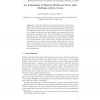Free Online Productivity Tools
i2Speak
i2Symbol
i2OCR
iTex2Img
iWeb2Print
iWeb2Shot
i2Type
iPdf2Split
iPdf2Merge
i2Bopomofo
i2Arabic
i2Style
i2Image
i2PDF
iLatex2Rtf
Sci2ools
109
click to vote
ICN
2001
Springer
2001
Springer
An Evaluation of Shared Multicast Trees with Multiple Active Cores
Abstract. Core-based multicast trees use less router state, but have significant drawbacks when compared to shortest-path trees, namely higher delay and poor fault tolerance. We evaluate the feasibility of using multiple independent cores within a shared multicast tree. We consider several basic designs and discuss how using multiple cores improves fault tolerance without sacrificing router state. We examine the performance of multiple-core trees with respect to single-core trees and find that adding cores significantly lowers delay without increasing cost. Moreover, it takes only a small number of cores, placed with a k-center approximation, for a multiple-core tree to have lower delay than a single-core tree with optimal core placement. We also find that traffic concentration is avoided as long as the load is spread among a set of cores. These results indicate that shared trees with multiple active cores are a viable alternative to shortest-path trees.
Related Content
| Added | 30 Jul 2010 |
| Updated | 30 Jul 2010 |
| Type | Conference |
| Year | 2001 |
| Where | ICN |
| Authors | Daniel Zappala, Aaron Fabbri |
Comments (0)

